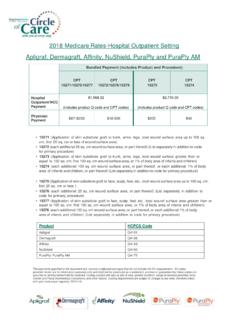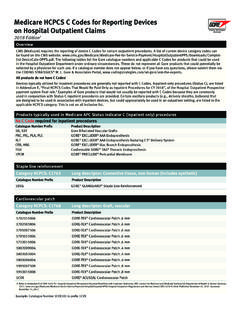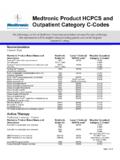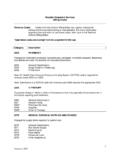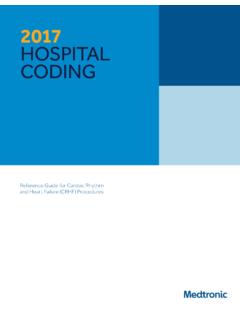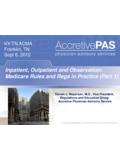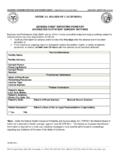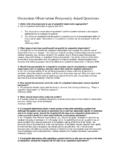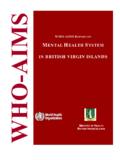Transcription of Hospital Charges and Reimbursement for Drugs
1 THE MORAN COMPANY Hospital Charges and Reimbursement for Drugs : Analysis of Markups Relative to Acquisition Cost Prepared for: The Pharmaceutical Research and Manufacturers of America October 2017 2 Hospital Charges and Reimbursement for Drugs : Analysis of Markups Relative to Acquisition Cost Analyses of prescription drug spending trends may not always include the role various parts of the pharmaceutical supply chain play in those trends. This analysis examines Hospital Charges and Reimbursement for 20 Drugs for which Hospital Reimbursement data is provided in the Magellan Rx Management Medical Pharmacy Trend Report : 2016 Seventh Edition (the Magellan report).1 Charges were calculated from claims data, as described in the methodology at the end of this report. Magellan reports that prescriptions in the Hospital outpatient setting account for 52% of spending on medical-benefit Drugs ( Drugs , typically physician-administered, that are reimbursed under health plans medical benefit rather than the pharmacy benefit) for commercial The tables that follow analyze Hospital mark-ups and margins by site of service for 20 individual Drugs for commercial payers.
2 That is, based on publicly available data, we estimate how much hospitals paid, on average, to acquire a drug from its manufacturer and then calculate the amount by which Hospital Charges and commercial insurers payment to hospitals for those Drugs exceeded their acquisition cost. As discussed below, our estimate of Hospital markups and the amount of payments in excess of hospitals cost of purchasing a drug are likely conservative. Table One: Analysis of Hospital Charge Information drug Estimated Hospital Charge per Claim Estimated Hospital Acquisition Cost per Claim (ASP) 3 Mark-up: Hospital Charge-Cost Hospital Charge/ Cost Total Ratio: Hospital Charge/ Cost Weighted by PMPM Amount 4 drug 1 $ 76,660 $ 19,792 $ 56,868 387% drug 2 $ 71,764 $ 14,776 $ 56,987 486% drug 3 $ 14,254 $ 3,431 $ 10,823 416% drug 4 $ 63,514 $ 4,531 $ 58,984 1402% drug 5 $ 20,572 $ 4,917 $ 15,656 418% drug 6 $ 16,763 $ 4,348 $ 12,415 386% drug 7 $ 14,303 $ 3,785 $ 10,518 378% drug 8 $ 15,721 $ 2,693 $ 13,029 584% drug 9 $ 14.
3 210 $ 2,841 $ 11,369 500% drug 10 $ 13,039 $ 2,968 $ 10,071 439% drug 11 $ 8,323 $ 2,584 $ 5,739 322% drug 12 $ 11,842 $ 2,155 $ 9,687 550% drug 13 $ 16,556 $ 2,290 $ 14,266 723% drug 14 $ 9,110 $ 1,720 $ 7,391 530% drug 15 $ 5,360 $ 1,911 $ 3,449 281% drug 16 $ 4,783 $ 1,657 $ 3,125 289% drug 17 $ 2,528 $ 442 $ 2,086 572% drug 18 $ 1,923 $ 642 $ 1,281 299% drug 19 $ 1,536 $ 198 $ 1,338 776% drug 20 $ 775 $ 191 $ 583 405% 1 The Magellan Rx Management Medical Pharmacy Trend Report : 2016 Seventh Edition includes both (1) a 2016 survey of health plans representing more than 109 million medical pharmacy lives and (2) analyses of 2015 commercial and Medicare Advantage medical paid claims data.
4 2 The Magellan Rx Management Medical Pharmacy Trend Report : 2016 Seventh Edition. Available at: (Accessed October 14, 2017) 3 We estimated that the Hospital s acquisition cost is equal to the manufacturer s average sales price (ASP) made available through the Centers for Medicare & Medicaid Services. As described in the text, this is likely a conservative estimate. ASP data obtained from the October 2015 ASP Pricing File. Available at: (Accessed October 14, 2017) 4 Per member per month (PMPM) amount obtained from the Magellan Rx Management Medical Pharmacy Trend Report : 2016 Seventh Edition. 3 As shown in Table One, on average hospitals mark-up these 20 Drugs 487 percent, though the mark-up varies materially from product to product. While we are not aware of common Reimbursement frameworks that are denoted in terms of 100% of billed Charges , Hospital outpatient departments are reimbursed a percent of Charges for 54% of commercial lives according to the Magellan report, and Hospital Charges do influence patient payments, particularly for the These Charges exclude fees charged for administering the drug .
5 Table Two: Comparison of Commercial Reimbursement with Average Sales Price (ASP) drug Hospital Outpatient Commercial Reimbursement per Claim Estimated Hospital Acquisition Cost per Claim (ASP) Margin: Hospital Reimbursement - Cost Hospital Reimbursement /Cost Total Ratio: Hospital Reimbursement /Cost Weighted by PMPM Amount drug 1 $ 39,822 $ 19,792 $ 20,030 201% drug 2 $ 27,049 $ 14,776 $ 12,273 183% drug 3 $ 10,159 $ 3,431 $ 6,728 296% drug 4 $ 9,660 $ 4,531 $ 5,129 213% drug 5 $ 9,607 $ 4,917 $ 4,690 195% drug 6 $ 8,676 $ 4,348 $ 4,328 200% drug 7 $ 8,433 $ 3,785 $ 4,648 223% drug 8 $ 7,759 $ 2,693 $ 5.
6 066 288% drug 9 $ 6,718 $ 2,841 $ 3,877 236% drug 10 $ 6,477 $ 2,968 $ 3,509 218% drug 11 $ 6,388 $ 2,584 $ 3,804 247% drug 12 $ 5,394 $ 2,155 $ 3,239 250% drug 13 $ 4,833 $ 2,290 $ 2,543 211% drug 14 $ 4,414 $ 1,720 $ 2,694 257% drug 15 $ 3,969 $ 1,911 $ 2,058 208% drug 16 $ 2,680 $ 1,657 $ 1,023 162% drug 17 $ 1,374 $ 442 $ 932 311% drug 18 $ 1,249 $ 642 $ 607 194% drug 19 $ 693 $ 198 $ 495 350% drug 20 $ 627 $ 191 $ 436 328% As shown in Table Two, the data from the Magellan report support the conclusion that commercial payers are reimbursing medical benefit Drugs at rates that are 252 percent of estimated Hospital acquisition cost, on average.
7 We believe average sales price (ASP) to be a conservative estimate of hospitals acquisition cost and that this analysis has likely underestimated Hospital mark-ups and margins, primarily because our analysis did not account for 340B discounts. More than half (61%) of Part B outpatient drug sales to hospitals are at 340B Similar patterns likely exist for the commercial market. On average, 340B prices are significantly lower than ASP about below ASP according to the Medicare Payment Advisory Commission (MedPAC).7 Therefore, on average, Drugs purchased at 340B prices will have larger margins than shown above. For instance, in the case of a drug with an ASP of $2,500 and assuming the weighted average 252% 5 Michael Batty and Benedic Ippolito. Mystery Of The Chargemaster: Examining The Role Of Hospital List Prices In What Patients Actually Pay. Health Affairs 36, (2017): 689-696.
8 6 The Alliance for Integrity and Reform of 340B. 340B Hospitals vs. Non-340B Hospitals: Growth and Distribution of Physician-Administered drug Reimbursement Across Ten Therapeutic Available at: (Accessed October 14, 2017) 7 Medicare Payment Advisory Commission (MedPAC). Report to the Congress: Overview of the 340B drug Pricing Program. May 2015. Available at: (Accessed October 14, 2017) 4 of commercial insurance Reimbursement to ASP reported above, payment to the Hospital would exceed the Hospital s cost of acquiring the drug , on average, by $3,800. If the same drug is acquired through 340B at a discount ($1,937), commercial insurance payment to the Hospital would exceed the Hospital s cost of acquiring the drug by 325% or $4,362, on Methodology Hospital Reimbursement cost per claim for 2015 was obtained from the Magellan report. Units per claim values were calculated by dividing commercial Hospital cost-per-claim data by cost-per-unit data from that report.
9 We calculate the ASP per claim by multiplying the Medicare ASP per unit for the same 2015 time period by the number of units. This methodology is consistent with an analysis previously conducted by the drug Channels We calculated the Hospital charge per claim using the average charge per unit from the 2015 Medicare 100% Outpatient Standard Analytic File and the units per claim from the Magellan report. We expect charge per unit to be roughly the same for Medicare and commercially insured patients. The average total mark-up and total margin across the 20 Drugs were both weighted using drug -level commercial per member per month (PMPM) data from the Magellan report. Weighting by PMPM reflects both the Reimbursement amount and volume that each of the 20 Drugs make up in the commercial market. 8 Calculated as a commercial payment of $6,300 [$2,500 * ]. Payment would exceed acquisition by approximately $3,800 [$6,300 - $2,500] in a non-340B facility.
10 In a 340B facility, acquisition cost would be approximately $1,938 [ * $2,500], leading to payment exceeding acquisition by $4,362 [$6,300 - $1938] or times [$6,300 / $1,938]. 9 Fein, Adam. Latest Data Show That Hospitals Are Still Specialty drug Profiteers. drug Channels Institute. 2017. Available at: (Accessed October 13, 2017)
